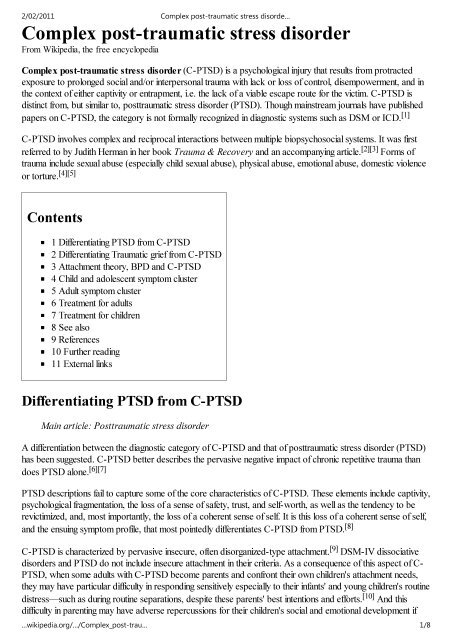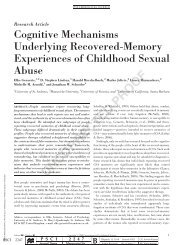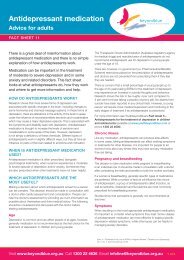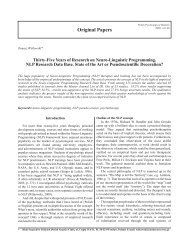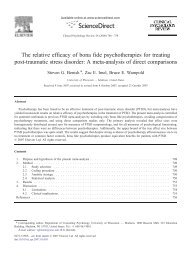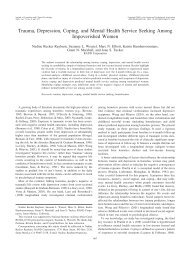Complex post-traumatic stress disorder - Wikipedia, the free ...
Complex post-traumatic stress disorder - Wikipedia, the free ...
Complex post-traumatic stress disorder - Wikipedia, the free ...
Create successful ePaper yourself
Turn your PDF publications into a flip-book with our unique Google optimized e-Paper software.
2/02/2011 <strong>Complex</strong> <strong>post</strong>-<strong>traumatic</strong> <strong>stress</strong> disorde…<br />
<strong>Complex</strong> <strong>post</strong>-<strong>traumatic</strong> <strong>stress</strong> <strong>disorder</strong><br />
From <strong>Wikipedia</strong>, <strong>the</strong> <strong>free</strong> encyclopedia<br />
<strong>Complex</strong> <strong>post</strong>-<strong>traumatic</strong> <strong>stress</strong> <strong>disorder</strong> (C-PTSD) is a psychological injury that results from protracted<br />
exposure to prolonged social and/or interpersonal trauma with lack or loss of control, disempowerment, and in<br />
<strong>the</strong> context of ei<strong>the</strong>r captivity or entrapment, i.e. <strong>the</strong> lack of a viable escape route for <strong>the</strong> victim. C-PTSD is<br />
distinct from, but similar to, <strong>post</strong><strong>traumatic</strong> <strong>stress</strong> <strong>disorder</strong> (PTSD). Though mainstream journals have published<br />
papers on C-PTSD, <strong>the</strong> category is not formally recognized in diagnostic systems such as DSM or ICD. [1]<br />
C-PTSD involves complex and reciprocal interactions between multiple biopsychosocial systems. It was first<br />
referred to by Judith Herman in her book Trauma & Recovery and an accompanying article. [2][3] Forms of<br />
trauma include sexual abuse (especially child sexual abuse), physical abuse, emotional abuse, domestic violence<br />
or torture. [4][5]<br />
Contents<br />
1 Differentiating PTSD from C-PTSD<br />
2 Differentiating Traumatic grief from C-PTSD<br />
3 Attachment <strong>the</strong>ory, BPD and C-PTSD<br />
4 Child and adolescent symptom cluster<br />
5 Adult symptom cluster<br />
6 Treatment for adults<br />
7 Treatment for children<br />
8 See also<br />
9 References<br />
10 Fur<strong>the</strong>r reading<br />
11 External links<br />
Differentiating PTSD from C-PTSD<br />
Main article: Post<strong>traumatic</strong> <strong>stress</strong> <strong>disorder</strong><br />
A differentiation between <strong>the</strong> diagnostic category of C-PTSD and that of <strong>post</strong><strong>traumatic</strong> <strong>stress</strong> <strong>disorder</strong> (PTSD)<br />
has been suggested. C-PTSD better describes <strong>the</strong> pervasive negative impact of chronic repetitive trauma than<br />
does PTSD alone. [6][7]<br />
PTSD descriptions fail to capture some of <strong>the</strong> core characteristics of C-PTSD. These elements include captivity,<br />
psychological fragmentation, <strong>the</strong> loss of a sense of safety, trust, and self-worth, as well as <strong>the</strong> tendency to be<br />
revictimized, and, most importantly, <strong>the</strong> loss of a coherent sense of self. It is this loss of a coherent sense of self,<br />
and <strong>the</strong> ensuing symptom profile, that most pointedly differentiates C-PTSD from PTSD. [8]<br />
C-PTSD is characterized by pervasive insecure, often disorganized-type attachment. [9] DSM-IV dissociative<br />
<strong>disorder</strong>s and PTSD do not include insecure attachment in <strong>the</strong>ir criteria. As a consequence of this aspect of C-<br />
PTSD, when some adults with C-PTSD become parents and confront <strong>the</strong>ir own children's attachment needs,<br />
<strong>the</strong>y may have particular difficulty in responding sensitively especially to <strong>the</strong>ir infants' and young children's routine<br />
di<strong>stress</strong>—such as during routine separations, despite <strong>the</strong>se parents' best intentions and efforts. [10] And this<br />
difficulty in parenting may have adverse repercussions for <strong>the</strong>ir children's social and emotional development if<br />
…wikipedia.org/…/<strong>Complex</strong>_<strong>post</strong>-trau… 1/8
2/02/2011 <strong>Complex</strong> <strong>post</strong>-<strong>traumatic</strong> <strong>stress</strong> disorde…<br />
parents with this condition and <strong>the</strong>ir children do not receive appropriate treatment. [11][12]<br />
Differentiating Traumatic grief from C-PTSD<br />
Main articles: Grief and Grief counseling<br />
Traumatic grief [13][14][15][16] or complicated mourning [17] are conditions [18] where both trauma and grief<br />
coincide. If a <strong>traumatic</strong> event was only life threatening <strong>the</strong>n more likely <strong>the</strong> survivor will experience <strong>post</strong><strong>traumatic</strong><br />
<strong>stress</strong> symptoms. If <strong>the</strong> survivor was close to <strong>the</strong> person who died, <strong>the</strong>n more likely symptoms of grief<br />
will also develop. When <strong>the</strong> death is of a loved one and was sudden or violent <strong>the</strong>n both symptoms coincide.<br />
This is likely in children exposed to community violence. [19]<br />
For C-PTSD to manifest <strong>the</strong> violence would occur under conditions of captivity, loss of control and<br />
disempowerment, coinciding with <strong>the</strong> death of a friend or loved one in life threatening circumstances. This again<br />
is most likely for children and stepchildren who experience prolonged domestic or chronic community violence<br />
that ultimately results in <strong>the</strong> death of friends and loved ones. The phenomena of <strong>the</strong> increased risk of violence<br />
and death of stepchildren is referred to as <strong>the</strong> Cinderella effect.<br />
There are conceptual links between trauma and bereavement since loss of a loved one is inherently <strong>traumatic</strong>. [20]<br />
Attachment <strong>the</strong>ory, BPD and C-PTSD<br />
Main articles: Attachment <strong>the</strong>ory and Borderline personality <strong>disorder</strong><br />
See also: Attachment in adults, Attachment in children, Attachment <strong>disorder</strong>, Attachment-based<br />
psycho<strong>the</strong>rapy, Cinderella effect, Self-injury, and Emotionally focused <strong>the</strong>rapy<br />
This controversial area [21] underlines <strong>the</strong> fragility of C-PTSD as an empirical diagnostic category separate from<br />
PTSD. [22][23]<br />
C-PTSD may have originated from observations of acute breakthrough of borderline personality (BPD)<br />
symptoms in trauma victims. [citation needed] This could be diagnosed as PTSD with borderline features, where<br />
<strong>the</strong> symptoms of BPD were not sufficient to sustain a (hypo<strong>the</strong>tical) dual diagnosis of BPD and PTSD. C-PTSD<br />
may share some symptoms with both PTSD and BPD. [24] Judith Herman has suggested that C-PTSD be used<br />
in place of borderline. [25]<br />
It may help to understand <strong>the</strong> intersection of attachment <strong>the</strong>ory with C-PTSD and BPD if one reads <strong>the</strong><br />
following opinion of Bessel A. van der Kolk toge<strong>the</strong>r with an understanding drawn from a description of BPD:<br />
Uncontrollable disruptions or distortions of attachment bonds precede <strong>the</strong> development of <strong>post</strong><strong>traumatic</strong><br />
<strong>stress</strong> syndromes. People seek increased attachment in <strong>the</strong> face of danger. Adults, as<br />
well as children, may develop strong emotional ties with people who intermittently harass, beat,<br />
and, threaten <strong>the</strong>m. The persistence of <strong>the</strong>se attachment bonds leads to confusion of pain and love.<br />
Trauma can be repeated on behavioural, emotional, physiologic, and neuroendocrinologic levels.<br />
Repetition on <strong>the</strong>se different levels causes a large variety of individual and social suffering. Anger<br />
directed against <strong>the</strong> self or o<strong>the</strong>rs is always a central problem in <strong>the</strong> lives of people who have been<br />
violated and this is itself a repetitive re-enactment of real events from <strong>the</strong> past. Compulsive<br />
repetition of <strong>the</strong> trauma usually is an unconscious process that, although it may provide a temporary<br />
sense of mastery or even pleasure, ultimately perpetuates chronic feelings of helplessness and a<br />
subjective sense of being bad and out of control. Gaining control over one's current life, ra<strong>the</strong>r than<br />
repeating trauma in action, mood, or somatic states, is <strong>the</strong> goal of healing. [26][27]<br />
…wikipedia.org/…/<strong>Complex</strong>_<strong>post</strong>-trau… 2/8
2/02/2011 <strong>Complex</strong> <strong>post</strong>-<strong>traumatic</strong> <strong>stress</strong> disorde…<br />
Seeking increased attachment to people, especially to care-givers who inflict pain, confuses love and pain and<br />
increases <strong>the</strong> likelihood of a captivity like that of betrayal bonding, [28] and of disempowerment and lack of<br />
control. If <strong>the</strong> situation is perceived as life threatening <strong>the</strong>n <strong>traumatic</strong> <strong>stress</strong> responses will likely arise and C-<br />
PTSD more likely diagnosed in a situation of insecure attachment than PTSD. At what point do <strong>the</strong> complex,<br />
reciprocal biopsychosocial responses to prolonged and extreme abuse evolve into BPD? This may depend on<br />
<strong>the</strong> timing, intensity and duration of <strong>the</strong> abuse and an as yet unidentified predisposition to BPD that results in a<br />
reset of <strong>the</strong> neuroendocrinologic levels of <strong>the</strong> body [citation needed] in a self-reinforcing pattern recognisable as<br />
<strong>the</strong> symptom cluster of BPD.<br />
However, 25% of those diagnosed with BPD have no history of childhood neglect or abuse and individuals are<br />
six times as likely to develop BPD if <strong>the</strong>y have a relative who was so diagnosed [citation needed] compared to<br />
those who do not. One conclusion is that <strong>the</strong>re is a genetic predisposition to BPD unrelated to trauma.<br />
Researchers conducting a longitudinal investigation of identical twins found that "genetic factors play a major role<br />
in individual differences of borderline personality <strong>disorder</strong> features in Western society." [29][30]<br />
Child and adolescent symptom cluster<br />
Cook and o<strong>the</strong>rs [31][32] describe symptoms and behavioural characteristics in seven domains:<br />
1. Attachment - "problems with relationship boundaries, lack of trust, social isolation, difficulty perceiving<br />
and responding to o<strong>the</strong>r’s emotional states, and lack of empathy"<br />
2. Biology - "sensory-motor developmental dysfunction, sensory-integration difficulties, somatization, and<br />
increased medical problems"<br />
3. Affect or emotional regulation - "poor affect regulation, difficulty identifying and expressing emotions<br />
and internal states, and difficulties communicating needs, wants, and wishes"<br />
4. Dissociation - "amnesia, depersonalization, discrete states of consciousness with discrete memories,<br />
affect, and functioning, and impaired memory for state-based events"<br />
5. Behavioural control - "problems with impulse control, aggression, pathological self-soothing, and sleep<br />
problems"<br />
6. Cognition - "difficulty regulating attention, problems with a variety of "executive functions" such as<br />
planning, judgement, initiation, use of materials, and self- monitoring, difficulty processing new<br />
information, difficulty focusing and completing tasks, poor object constancy, problems with "cause-effect"<br />
thinking, and language developmental problems such as a gap between receptive and expressive<br />
communication abilities."<br />
7. Self-concept -"fragmented and disconnected autobiographical narrative, disturbed body image, low selfesteem,<br />
excessive shame, and negative internal working models of self".<br />
Source of quotes [33]<br />
Adult symptom cluster<br />
Adults with C-PTSD have sometimes experienced prolonged interpersonal traumatization as children as well as<br />
prolonged trauma as adults. This early injury interrupts <strong>the</strong> development of a robust sense of self and of o<strong>the</strong>rs.<br />
Because physical and emotional pain or neglect was often inflicted by attachment figures such as caregivers or<br />
older siblings, <strong>the</strong>se individuals may develop a sense that <strong>the</strong>y are fundamentally flawed and that o<strong>the</strong>rs cannot<br />
be relied upon. [34][35]<br />
This can become a pervasive way of relating to o<strong>the</strong>rs in adult life described as insecure attachment. The<br />
diagnosis of dissociative <strong>disorder</strong> and PTSD in <strong>the</strong> current DSM-IV TR do not include insecure attachment as a<br />
…wikipedia.org/…/<strong>Complex</strong>_<strong>post</strong>-trau… 3/8
2/02/2011 <strong>Complex</strong> <strong>post</strong>-<strong>traumatic</strong> <strong>stress</strong> disorde…<br />
symptom. Individuals with <strong>Complex</strong> PTSD also demonstrate lasting personality disturbances with a significant<br />
risk of revictimization. [36]<br />
Six clusters of symptom have been suggested for diagnosis of C-PTSD. [37][38] These are (1) alterations in<br />
regulation of affect and impulses; (2) alterations in attention or consciousness; (3) alterations in self-perception;<br />
(4) alterations in relations with o<strong>the</strong>rs; (5) somatization, and (6) alterations in systems of meaning. [37]<br />
Experiences in <strong>the</strong>se areas may include: [7][8]<br />
Difficulties regulating emotions, including symptoms such as persistent sadness, suicidal thoughts,<br />
explosive anger, or covert anger.<br />
Variations in consciousness, such as forgetting <strong>traumatic</strong> events, reliving <strong>traumatic</strong> events, or having<br />
episodes of dissociation (during which one feels detached from one's mental processes or body).<br />
Changes in self-perception, such as a sense of helplessness, shame, guilt, stigma, and a sense of<br />
being completely different from o<strong>the</strong>r human beings.<br />
Varied changes in <strong>the</strong> perception of <strong>the</strong> perpetrator, such as attributing total power to <strong>the</strong><br />
perpetrator or becoming preoccupied with <strong>the</strong> relationship to <strong>the</strong> perpetrator, including a<br />
preoccupation with revenge.<br />
Alterations in relations with o<strong>the</strong>rs, including isolation, distrust, or a repeated search for a rescuer.<br />
Loss of, or changes in, one's system of meanings, which may include a loss of sustaining faith or a<br />
sense of hopelessness and despair.<br />
Treatment for adults<br />
Herman [39] believes recovery from C-PTSD occurs in three stages. These are: establishing safety, remembrance<br />
and mourning for what was lost, and reconnecting with community and more broadly, society. Herman believes<br />
recovery can only occur within a healing relationship and only if <strong>the</strong> survivor is empowered by that relationship.<br />
<strong>Complex</strong> trauma means complex reactions and this leads to complex treatments. Hence treatment for C-PTSD<br />
requires a multi-modal approach. [40] It has been suggested that treatment for C-PTSD should differ from<br />
treatment for PTSD by focusing on problems that cause more functional impairment than <strong>the</strong> PTSD symptoms.<br />
These problems include emotional dysregulation, dissociation, and interpersonal problems. [41] Six suggested<br />
core components of complex trauma treatment include: [40]<br />
1. Safety<br />
2. Self-regulation<br />
3. Self-reflective information processing<br />
4. Traumatic experiences integration<br />
5. Relational engagement<br />
6. Positive affect enhancement<br />
Multiple treatments have been suggested for C-PTSD. Among <strong>the</strong>se treatments are experiential and emotionally<br />
focused <strong>the</strong>rapy, internal family systems <strong>the</strong>rapy, sensorimotor psycho<strong>the</strong>rapy, cognitive behavioral <strong>the</strong>rapy,<br />
family systems <strong>the</strong>rapy and group <strong>the</strong>rapy. [42]<br />
…wikipedia.org/…/<strong>Complex</strong>_<strong>post</strong>-trau… 4/8
2/02/2011 <strong>Complex</strong> <strong>post</strong>-<strong>traumatic</strong> <strong>stress</strong> disorde…<br />
Treatment for children<br />
The utility of PTSD derived psycho<strong>the</strong>rapies for assisting children with C-PTSD is uncertain. This area of<br />
diagnosis and treatment calls for caution in use of <strong>the</strong> category C-PTSD. Ford and van der Kolk [43] have<br />
suggested that C-PTSD may not be as useful a category for diagnosis and treatment of children as a proposed<br />
category of DTD (developmental trauma <strong>disorder</strong>). For DTD to be diagnosed it requires a<br />
'history of exposure to early life developmentally adverse interpersonal trauma such as sexual<br />
abuse, physical abuse, violence, <strong>traumatic</strong> losses of o<strong>the</strong>r significant disruption or betrayal of <strong>the</strong><br />
child's relationships with primary caregivers, which has been <strong>post</strong>ulated as an etiological basis for<br />
complex <strong>traumatic</strong> <strong>stress</strong> <strong>disorder</strong>s. Diagnosis, treatment planning and outcome are always<br />
relational.' [44]<br />
Since C-PTSD or DTD in children is often caused by chronic maltreatment, neglect or abuse in a care-giving<br />
relationship <strong>the</strong> first element of <strong>the</strong> biopsychosocial system to address is that relationship. This invariably involves<br />
some sort of child protection agency. This both widens <strong>the</strong> range of support that can be given to <strong>the</strong> child but<br />
also <strong>the</strong> complexity of <strong>the</strong> situation, since <strong>the</strong> agency's statutory legal obligations may <strong>the</strong>n need to be enforced.<br />
A number of practical, <strong>the</strong>rapeutic and ethical principles for assessment and intervention have been developed<br />
and explored in <strong>the</strong> field:<br />
Identifying and addressing threats to <strong>the</strong> child's or family's safety and stability are <strong>the</strong> first priority.<br />
A relational bridge must be developed to engage, retain and maximize <strong>the</strong> benefit for <strong>the</strong> child and<br />
caregiver.<br />
Diagnosis, treatment planning and outcome monitoring are always relational (and) strengths based.<br />
All phases of treatment should aim to enhance self-regulation competencies.<br />
Determining with whom, when and how to address <strong>traumatic</strong> memories.<br />
Preventing and managing relational discontinuities and psychosocial crises. [45]<br />
See also<br />
Attachment <strong>the</strong>ory<br />
Attachment in adults<br />
Attachment in children<br />
Child Welfare<br />
Dyadic developmental psycho<strong>the</strong>rapy<br />
Trauma model<br />
Emotional self-regulation<br />
Stress (biological)<br />
Post<strong>traumatic</strong> <strong>stress</strong> <strong>disorder</strong><br />
Dissociation<br />
Bipolar Disorder<br />
Borderline personality <strong>disorder</strong><br />
Reactive attachment <strong>disorder</strong><br />
Psychoneuroimmunology<br />
Attachment-based <strong>the</strong>rapy (children)<br />
Child psycho<strong>the</strong>rapy<br />
Maladaptive daydreaming<br />
Play <strong>the</strong>rapy<br />
Parent-Child Interaction Therapy (PCIT)<br />
Psychosomatic medicine<br />
Dyadic Developmental Psycho<strong>the</strong>rapy<br />
The WAVE Trust<br />
References<br />
1. ^ Roth S, Newman E, Pelcovitz D, van der Kolk B, Mandel FS (1997). "<strong>Complex</strong> PTSD in victims exposed to<br />
sexual and physical abuse: results from <strong>the</strong> DSM-IV Field Trial for Post<strong>traumatic</strong> Stress Disorder". J Trauma<br />
…wikipedia.org/…/<strong>Complex</strong>_<strong>post</strong>-trau… 5/8
2/02/2011 <strong>Complex</strong> <strong>post</strong>-<strong>traumatic</strong> <strong>stress</strong> disorde…<br />
Stress 10 (4): 539–55. doi:10.1002/jts.2490100403 (http://dx.doi.org/10.1002%2Fjts.2490100403) .<br />
PMID 9391940 (http://www.ncbi.nlm.nih.gov/pubmed/9391940) .<br />
2. ^ Herman, J.L. (1992(a)). Trauma and recovery. New York: Basic Books.<br />
3. ^ Herman, J. L. (1992(b)). <strong>Complex</strong> PTSD: A syndrome in survivors of prolonged and repeated trauma.<br />
Journal of Traumatic Stress, 5, 377-391.<br />
4. ^ Freyd, J.J. (1997) Violations of power, adaptive blindness, and betrayal trauma <strong>the</strong>ory. Feminism &<br />
Psychology, 7, 22-32<br />
5. ^ Veldhuis, C. B., & Freyd, J. J. (1999). Groomed for silence, groomed for betrayal. In M. Rivera (Ed.),<br />
Fragment by Fragment: Feminist Perspectives on Memory and Child Sexual Abuse (pp. 253-282).<br />
Charlottetown, PEI Canada: Gynergy Books<br />
6. ^ van der Kolk BA, Courtois CA (2005). "Editorial comments: <strong>Complex</strong> developmental trauma". J Trauma<br />
Stress 18 (5): 385–8. doi:10.1002/jts.20046 (http://dx.doi.org/10.1002%2Fjts.20046) . PMID 16281236<br />
(http://www.ncbi.nlm.nih.gov/pubmed/16281236) .<br />
7. ^ ab Julia M. Whealin, Ph.D. and Laurie Slone, Ph.D.. "<strong>Complex</strong> PTSD"<br />
(http://www.ncptsd.va.gov/ncmain/ncdocs/fact_shts/fs_complex_ptsd.html?<br />
opm=1&rr=rr89&srt=d&echorr=true) . National Center for Post<strong>traumatic</strong> Stress Disorder. United States<br />
Department of Veteran Affairs. http://www.ncptsd.va.gov/ncmain/ncdocs/fact_shts/fs_complex_ptsd.html?<br />
opm=1&rr=rr89&srt=d&echorr=true.<br />
8. ^ ab Herman, Judith Lewis (1997). Trauma and recovery: The aftermath of violence from domestic abuse to<br />
political terror. Basic Books. pp. 119–122. ISBN 0465087302.<br />
9. ^ van der Kolk, B.A., Roth, S., Pelcovitz, D., Sunday, S., & Spinazzola, J. (2005). Disorders of extreme <strong>stress</strong>:<br />
The empirical foundation of a complex adaptation to trauma. Journal of Traumatic Stress, 18, 389-39<br />
10. ^ Schechter DS, Coates, SW, Kaminer T, Coots T, Zeanah CH, Davies M, Schonfield IS, Marshall RD,<br />
Liebowitz MR Trabka KA, McCaw J, Myers MM (2008). Distorted maternal mental representations and<br />
atypical behavior in a clinical sample of violence-exposed mo<strong>the</strong>rs and <strong>the</strong>ir toddlers. Journal of Trauma and<br />
Dissociation , 9(2), 123-149.<br />
11. ^ Schechter DS, Willheim E (2009). Disturbances of attachment and parental psychopathology in early<br />
childhood. Infant and Early Childhood Mental Health Issue. Child and Adolescent Psychiatry Clinics of North<br />
America, 18(3), 665-687.<br />
12. ^ Schechter DS, Zygmunt A, Coates SW, Davies M, Trabka KA, McCaw J, Kolodji A., Robinson JL (2007).<br />
Caregiver traumatization adversely impacts young children’s mental representations of self and o<strong>the</strong>rs.<br />
Attachment & Human Development, 9(3), 187-205.<br />
13. ^ Bonanno, G.A. (2006). Is Complicated Grief a Valid Construct? Clinical Psychology: Science and Practice 13<br />
(2) , 129–134<br />
14. ^ Jacobs, Shelby, Carolyn Mazure, and Holly Prigerson. "Diagnostic Criteria for Traumatic Grief." Death<br />
Studies 24 (2000):185–199<br />
15. ^ Traumatic grief (http://www.ctsn-rcst.ca/Traumaticgrief.html)<br />
16. ^ Figley, C., Bride, B. & Mazza, N. (1997). Death and trauma: The traumatology of grieving. Philadelphia:<br />
Brunner/Mazel<br />
17. ^ Rando, T. (1993) Treatment of complicated mourning. Champaign, IL: Research Press<br />
18. ^ Rando, T. (1998). Complications in mourning <strong>traumatic</strong> death. In K. Doka (Ed.) Living with grief after<br />
sudden loss. Bristol, PA: Taylor & Francis<br />
19. ^ Pynoos, R. & Nader, K. (1988), Psychological first aid and treatment approach to children exposed to<br />
community violence: Research implications. Journal of Traumatic Stress, 1, 445-473.<br />
20. ^ Green, B. L. (2000) Traumatic loss: Conceptual and empirical links between trauma and bereavement. Journal<br />
of Personal and Interpersonal Loss, 5, 1-17<br />
21. ^ Clinical Psychology article on BPD/Dyslimbic brain function (http://www.peterfox.com.au/bpd.htm)<br />
22. ^ Luxenberg, T., Spinazzola, J., & van der Kolk, B. A. (2001). <strong>Complex</strong> trauma and <strong>disorder</strong>s of extreme<br />
<strong>stress</strong> (DESNOS) diagnosis, part one: Assessment [Electronic version]. Directions in Psychiatry, 21(25), 373-<br />
392.<br />
23. ^ Luxenberg, T., Spinazzola, J., Hidalgo, J., Hunt, C., & van der Kolk, B. A. (2001). <strong>Complex</strong> trauma and<br />
<strong>disorder</strong>s of extreme <strong>stress</strong> (DESNOS) part two: Treatment [Electronic version]. Directions in Psychiatry,<br />
21(26), 395-414<br />
24. ^ Taylor S, Asmundson GJ, Carleton RN (2006). "Simple versus complex PTSD: a cluster analytic<br />
investigation". J Anxiety Disord 20 (4): 459–72. doi:10.1016/j.janxdis.2005.04.003<br />
(http://dx.doi.org/10.1016%2Fj.janxdis.2005.04.003) . PMID 15979838<br />
…wikipedia.org/…/<strong>Complex</strong>_<strong>post</strong>-trau… 6/8
2/02/2011 <strong>Complex</strong> <strong>post</strong>-<strong>traumatic</strong> <strong>stress</strong> disorde…<br />
(http://www.ncbi.nlm.nih.gov/pubmed/15979838) .<br />
25. ^ Johnson, S. Emotionally Focused Couple Therapy for Trauma Survivors' Guilford Press 2002 Chapter 4 page<br />
75<br />
26. ^ [1] (http://www.cirp.org/library/psych/vanderkolk/)<br />
27. ^ Bessel A. van der Kolk, MD* The Compulsion to Repeat <strong>the</strong> Trauma Re-enactment, Revictimization, and<br />
Masochism Psychiatric Clinics of North America, Volume 12, Number 2, Pages 389-411, June 1989<br />
28. ^ Patrick J. Carnes 'The Betrayal Bond: Breaking Free of Exploitive Relationships' ISBN 1558745262 ISBN<br />
978-1558745261<br />
29. ^ Distel et al. Chromosome 9: linkage for borderline personality <strong>disorder</strong> features. Psychiatric Genetics, 2008;<br />
18 (6): 302 DOI: 10.1097/YPG.0b013e3283118468<br />
30. ^ Distel et al. Heritability of borderline personality <strong>disorder</strong> features is similar across three countries.<br />
Psychological Medicine, 2008; 38 (9): DOI: 10.1017/S0033291707002024<br />
31. ^ Cook, A., Blaustein, M., Spinazolla, J., van der Kolk, B. (2003) <strong>Complex</strong> trauma in children and adolescents.<br />
White paper from <strong>the</strong> national child <strong>traumatic</strong> <strong>stress</strong> network complex trauma task force. Los Angeles, CA:<br />
National Center for Child Traumatic Stress<br />
32. ^ Cook, A., Spinazzola, J., Ford, J., Lanktree, C., et al. (2005) <strong>Complex</strong> trauma in children and adolescents.<br />
Psychiatric Annals, 35:5, 390-398.<br />
33. ^ Trends in Research into C-PTSD (http://www.center4familydevelop.com/Trends%20in%20Research.pdf)<br />
34. ^ Herman, J.L. (1992). <strong>Complex</strong> PTSD: A syndrome in survivors of prolonged and repeated trauma. Journal of<br />
Traumatic Stress 5, 377-392.<br />
35. ^ Zlotnick, C., Zakriski, A.L., Shea, M.T., Costello, E., Begin, A., Pearlstein, T., & Simpson, E. (1996). The<br />
long-term sequelae of sexual abuse: Support for a complex <strong>post</strong><strong>traumatic</strong> <strong>stress</strong> <strong>disorder</strong>. Journal of Traumatic<br />
Stress, 9, 195-20<br />
36. ^ Ide, N., & Paez, A. (2000). <strong>Complex</strong> PTSD: A review of current issues. International Journal of Emergency<br />
Mental Health, 2, 43-49<br />
37. ^ ab Pelcovitz, D., van der Kolk, B.A., Roth, S., Mandel, F., Kaplan, S., & Resick, P. (1997). Development of<br />
a criteria set and a structured interview for <strong>the</strong> <strong>disorder</strong>s of extreme <strong>stress</strong> (SIDES). Journal of Traumatic<br />
Stress, 10, 3-16.<br />
38. ^ Roth, S., Newman, E., Pelcovitz, D., van der Kolk, B., & Mandel, F.S. (1997). <strong>Complex</strong> PTSD in victims<br />
exposed to sexual and physical abuse: Results from <strong>the</strong> DSM-IV Field Trial for Post<strong>traumatic</strong> Stress Disorder.<br />
Journal of Traumatic Stress 10, 539-556<br />
39. ^ Herman, J.L. (1992(a)). Trauma and recovery. New York: Basic Books<br />
40. ^ ab Cook, A.; Blaustein, M.; Spinazzola, J.; Van Der Kolk, B. (2005). "<strong>Complex</strong> trauma in children and<br />
adolescents" (http://doi.apa.org/?uid=2005-05449-004) . Psychiatric Annals 35 (5): 390–398.<br />
http://doi.apa.org/?uid=2005-05449-004. Retrieved 2008-03-29.<br />
41. ^ van der Kolk BA, Roth S, Pelcovitz D, Sunday S, Spinazzola J (2005). "Disorders of extreme <strong>stress</strong>: The<br />
empirical foundation of a complex adaptation to trauma". J Trauma Stress 18 (5): 389–99. doi:10.1002/jts.20047<br />
(http://dx.doi.org/10.1002%2Fjts.20047) . PMID 16281237 (http://www.ncbi.nlm.nih.gov/pubmed/16281237) .<br />
42. ^ Courtois, C>A.and Ford, J>D 'Treating <strong>Complex</strong> Traumatic Stress Disorders - an evidence based guide.<br />
2009 <strong>the</strong> Guilford Press<br />
43. ^ page 60 Chapter 3 in Courtois, CA.and Ford, J.D eds 'Treating <strong>Complex</strong> Traumatic Stress Disorders - an<br />
evidence based guide. 2009 <strong>the</strong> Guilford Press<br />
44. ^ Chapter 3 in Courtois, CA.and Ford, J.D eds 'Treating <strong>Complex</strong> Traumatic Stress Disorders - an evidence<br />
based guide. 2009 <strong>the</strong> Guilford Press<br />
45. ^ page 67 Chapter 3 in Courtois, CA.and Ford, J.D eds 'Treating <strong>Complex</strong> Traumatic Stress Disorders - an<br />
evidence based guide. 2009 <strong>the</strong> Guilford Press<br />
Fur<strong>the</strong>r reading<br />
Appleyard, K.; Osofsky, J.D. (2003). "Parenting after trauma: Supporting parents and caregivers in <strong>the</strong><br />
treatment of children impacted by violence". Infant Mental Health Journal 24 (2): 111–125.<br />
doi:10.1002/imhj.10050 (http://dx.doi.org/10.1002%2Fimhj.10050) .<br />
Cook, A.; Blaustein, M.;Spinazzola, J.; and van der Kolk, B., (2003) <strong>Complex</strong> trauma in children and<br />
adolescents. White paper from <strong>the</strong> National Child Traumatic Stress Newtork <strong>Complex</strong> Trauma Task<br />
…wikipedia.org/…/<strong>Complex</strong>_<strong>post</strong>-trau… 7/8
2/02/2011 <strong>Complex</strong> <strong>post</strong>-<strong>traumatic</strong> <strong>stress</strong> disorde…<br />
Force.<br />
Cook, A., Spinazzola, J., Ford, J., Lanktree, C., et al., (2005) <strong>Complex</strong> trauma in children and<br />
adolescents. Psychiatric Annals, 35, 390-398.<br />
Courtois, Christine A. (Editor), Ford, Julian D. PhD (Editor) 'Treating <strong>Complex</strong> Traumatic Stress<br />
Disorders' The Guilford Press; 1 edition (February 5, 2009) ISBN 1606230395 ISBN 978-<br />
1606230398<br />
Herman, JL (1997). Trauma and recovery: The aftermath of violence from domestic abuse to political<br />
terror. New York: Basic Books.<br />
Scott, Ca<strong>the</strong>rine V.; Briere, John (2006). Principles of Trauma Therapy : A Guide to Symptoms,<br />
Evaluation, and Treatment. Thousand Oaks: Sage Publications. ISBN 0-7619-2921-5.<br />
Ford JD (1999). "Disorders of extreme <strong>stress</strong> following war-zone military trauma: associated features of<br />
<strong>post</strong><strong>traumatic</strong> <strong>stress</strong> <strong>disorder</strong> or comorbid but distinct syndromes?". J Consult Clin Psychol 67 (1): 3–<br />
12. doi:10.1037/0022-006X.67.1.3 (http://dx.doi.org/10.1037%2F0022-006X.67.1.3) .<br />
PMID 10028203 (http://www.ncbi.nlm.nih.gov/pubmed/10028203) .<br />
van der Kolk, B.A., Roth, S., Pelcovitz, D., Sunday, S., & Spinazzola, J. (2005). "Disorders of extreme<br />
<strong>stress</strong>: <strong>the</strong> empirical foundation of a complex adaptation to trauma". Journal of Traumatic Stress 18,<br />
389-399.<br />
External links<br />
Post-<strong>traumatic</strong> <strong>stress</strong> (http://www.dmoz.org/Health/Mental_Health/Disorders/Anxiety/Post<strong>traumatic</strong>_Stress//)<br />
at <strong>the</strong> Open Directory Project<br />
Recommended DSM criteria (http://www.sasian.org/papers/cptsd.htm)<br />
Retrieved from "http://en.wikipedia.org/wiki/<strong>Complex</strong>_<strong>post</strong>-<strong>traumatic</strong>_<strong>stress</strong>_<strong>disorder</strong>"<br />
Categories: Stress | Abuse | Bullying | Traumatology | Anxiety <strong>disorder</strong>s | Mood <strong>disorder</strong>s | Psycho<strong>the</strong>rapy |<br />
Death<br />
This page was last modified on 27 January 2011 at 03:02.<br />
Text is available under <strong>the</strong> Creative Commons Attribution-ShareAlike License; additional terms may<br />
apply. See Terms of Use for details.<br />
<strong>Wikipedia</strong>® is a registered trademark of <strong>the</strong> Wikimedia Foundation, Inc., a non-profit organization.<br />
…wikipedia.org/…/<strong>Complex</strong>_<strong>post</strong>-trau… 8/8


